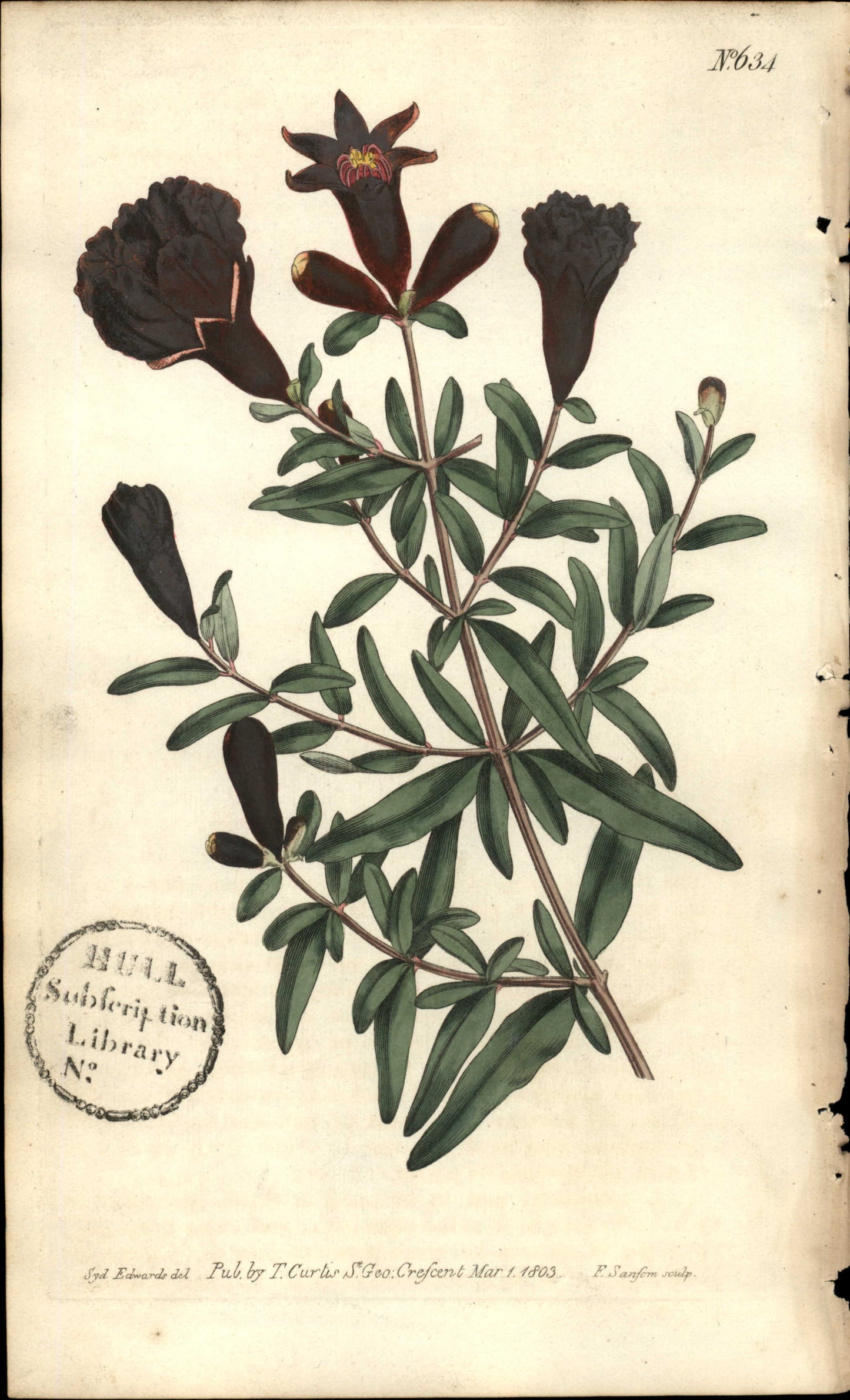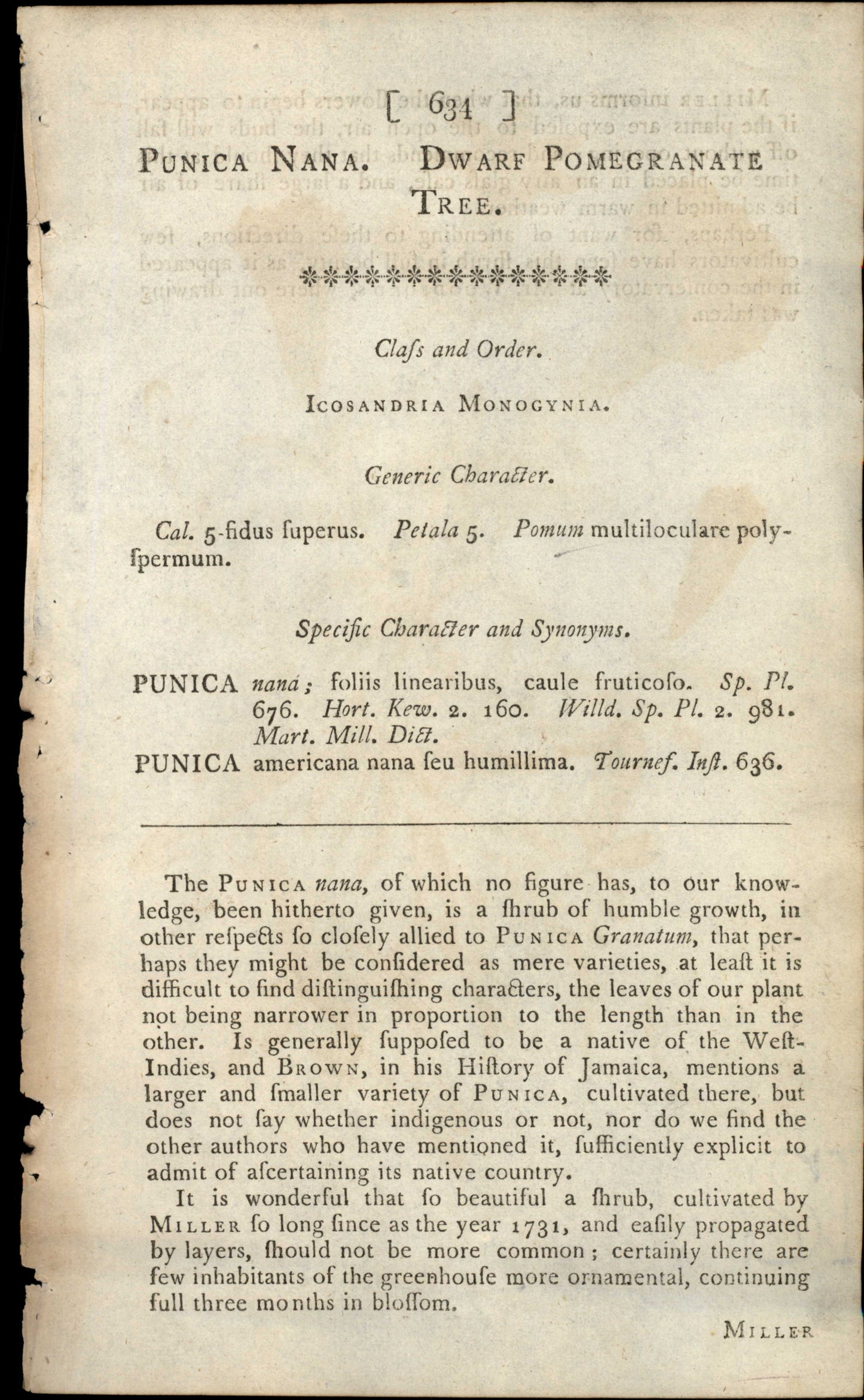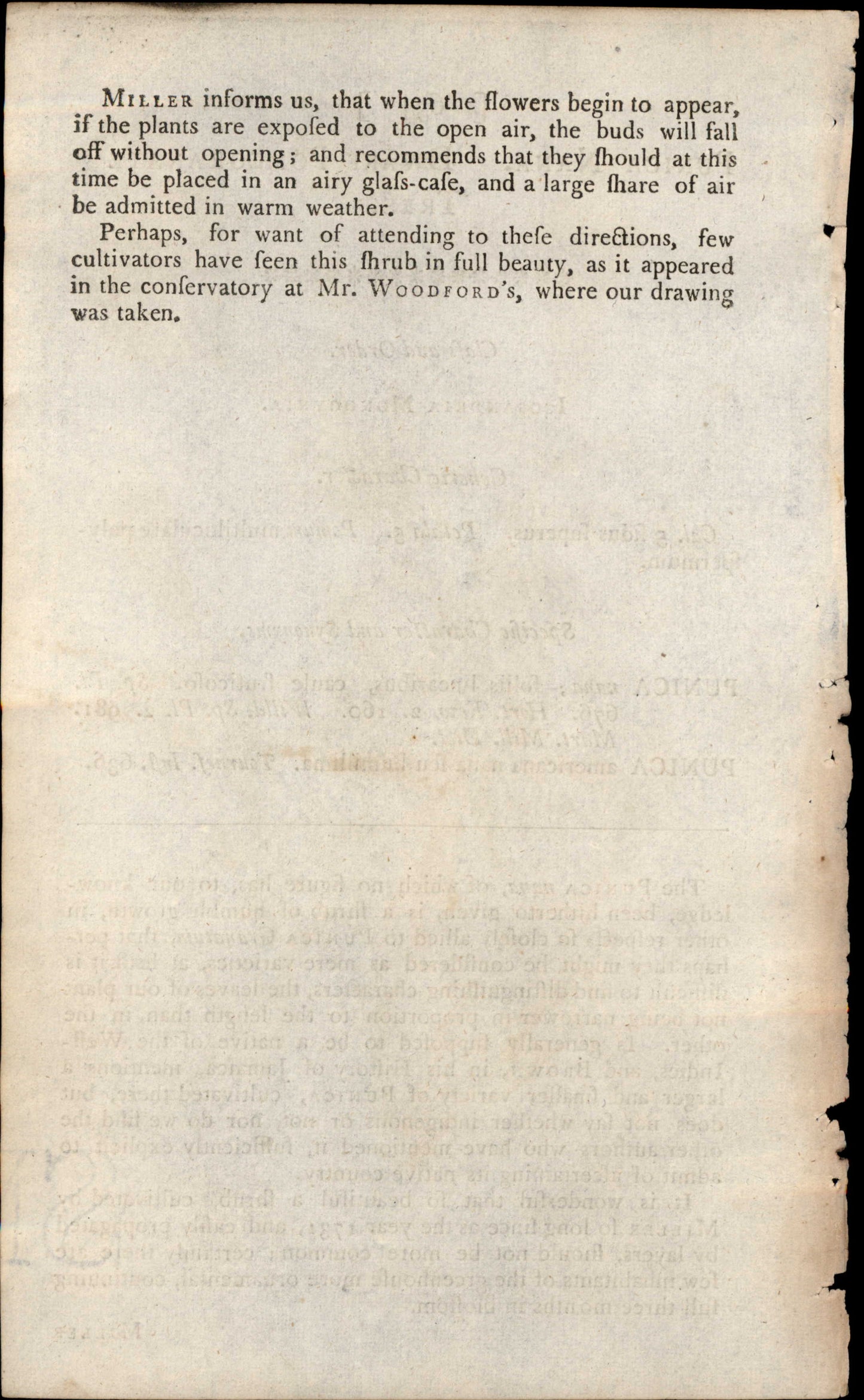Curtis Botanical Magazine
Plate 634 - Icosandria Monogynia
Plate 634 - Icosandria Monogynia
Couldn't load pickup availability
Plate 634
Classification: ICOSANDRIA MONOGYNIA
Publication Date: eved 2101
Description:
Botanical Description
PUNICA nana, of which no figure has, to our know- ledge, been hitherto given, is a fhrub of humble growth, in other refpects fo clofely allied to PUNICA Granatum, that per- haps they might be confidered as mere varieties, at leaft it is difficult to find diftinguifhing characters, the leaves of our plant not being narrower in proportion to the length than in the other. Is generally fuppofed to be a native of the Weft- Indies, and BROWN, in his Hiftory of Jamaica, mentions a larger and fmaller variety of PUNICA, cultivated there, but does not fay whether indigenous or not, nor do we find the other authors who have mentioned it, fufficiently explicit to admit of afcertaining its native country. It is wonderful that fo beautiful a fhrub, cultivated by MILLER fo long fince as the year 1731, and eafily propagated by layers, fhould not be more common; certainly there are few inhabitants of the greenhoufe more ornamental, continuing full three months in bloffom. MILLER --- CBM-ToList-634t.
Complete Botanical Text (Cleaned)
sofied [634] an ilst liv bud or is hoo of bloque os anel od li PUNICA NANA.
DWARF POMEGRANATE is to stadi spielbasa disip us ne ai bosiq. od smi TREE. usw nt bominibs ad watenoifisti star of gribnants to ja *************** 10/ eved 2101svilup girth 100 sT Class and Order.
ICOSANDRIA MONOGYNIA.
Generic Character.
W Cal. 5-fidus fuperus.
Petala 5. spermum.
Pomum multiloculare poly- specific Character and synonyms.
PUNICA naná; soliis linearibus, caule fruticoso. sp.
Pl. 676.
Hort.
Kew. 2. 160.
Willd. sp.
Pl. 2. 981.
Mart.
Mill.
Dict.
PUNICA americana nana feu humillima.
Tournef.
Inft. 636.
The PUNICA nana, of which no figure has, to our know- ledge, been hitherto given, is a shrub of humble growth, in other respects so closely allied to PUNICA Granatum, that per- haps they might be confidered as mere varieties, at least it is difficult to find distinguishing characters, the leaves of our plant not being narrower in proportion to the length than in the other.
Is generally supposed to be a native of the Weft- Indies, and BROWN, in his Hiftory of Jamaica, mentions a larger and fmaller variety of PUNICA, cultivated there, but does not fay whether indigenous or not, nor do we find the other authors who have mentioned it, sufficiently explicit to admit of ascertaining its native country.
It is wonderful that so beautiful a shrub, cultivated by MILLER so long fince as the year 1731, and easily propagated by layers, fhould not be more common; certainly there are few inhabitants of the greenhouse more ornamental, continuing full three months in blofsom.
MILLER HULL [subfcription Library N° No634 syd Edwards del Pub by T.
Curtis S.Geo: Crefcent Mar 1.1803 FSansom sculp MILLER insorms us, that when the flowers begin to appear, if the plants are expofed to the open air, the buds will fall off without opening; and recommends that they fhould at this time be placed in an airy glafs-cafe, and a large share of air be admitted in warm weather.
Perhaps, sor want of attending to these directions, few cultivators have seen this shrub in full beauty, as it appeared in the confervatory at Mr.
WOODFORD's, where our drawing was taken. sid sdi Colonial pluto M Doms AOIKUT davin omorbid read cudo boille dabola at 150 oved odw agnifies to imbs ans hitobaow ai cl od 20 pri pol ol 231M tom ad on blooval vd Sodas adi to amsindsdi wot
Raw OCR Text (Original)
sofied [634] an ilst liv bud or is hoo of bloque os anel od li PUNICA NANA. DWARF POMEGRANATE is to stadi spielbasa disip us ne ai bosiq. od smi TREE. usw nt bominibs ad watenoifisti star of gribnants to ja *************** 10/ eved 2101svilup girth 100 sT Class and Order. ICOSANDRIA MONOGYNIA. Generic Character. W Cal. 5-fidus fuperus. Petala 5. spermum. Pomum multiloculare poly- specific Character and synonyms. PUNICA naná; soliis linearibus, caule fruticoso. sp. Pl. 676. Hort. Kew. 2. 160. Willd. sp. Pl. 2. 981. Mart. Mill. Dict. PUNICA americana nana feu humillima. Tournef. Inft. 636. The PUNICA nana, of which no figure has, to our know- ledge, been hitherto given, is a shrub of humble growth, in other respects so closely allied to PUNICA Granatum, that per- haps they might be confidered as mere varieties, at least it is difficult to find distinguishing characters, the leaves of our plant not being narrower in proportion to the length than in the other. Is generally supposed to be a native of the Weft- Indies, and BROWN, in his Hiftory of Jamaica, mentions a larger and fmaller variety of PUNICA, cultivated there, but does not fay whether indigenous or not, nor do we find the other authors who have mentioned it, sufficiently explicit to admit of ascertaining its native country. It is wonderful that so beautiful a shrub, cultivated by MILLER so long fince as the year 1731, and easily propagated by layers, fhould not be more common; certainly there are few inhabitants of the greenhouse more ornamental, continuing full three months in blofsom. MILLER HULL [subfcription Library N° No634 syd Edwards del Pub by T. Curtis S.Geo: Crefcent Mar 1.1803 FSansom sculp MILLER insorms us, that when the flowers begin to appear, if the plants are expofed to the open air, the buds will fall off without opening; and recommends that they fhould at this time be placed in an airy glafs-cafe, and a large share of air be admitted in warm weather. Perhaps, sor want of attending to these directions, few cultivators have seen this shrub in full beauty, as it appeared in the confervatory at Mr. WOODFORD's, where our drawing was taken. sid sdi Colonial pluto M Doms AOIKUT davin omorbid read cudo boille dabola at 150 oved odw agnifies to imbs ans hitobaow ai cl od 20 pri pol ol 231M tom ad on blooval vd Sodas adi to amsindsdi wot
Original botanical print from Curtis's Botanical Magazine
Share







